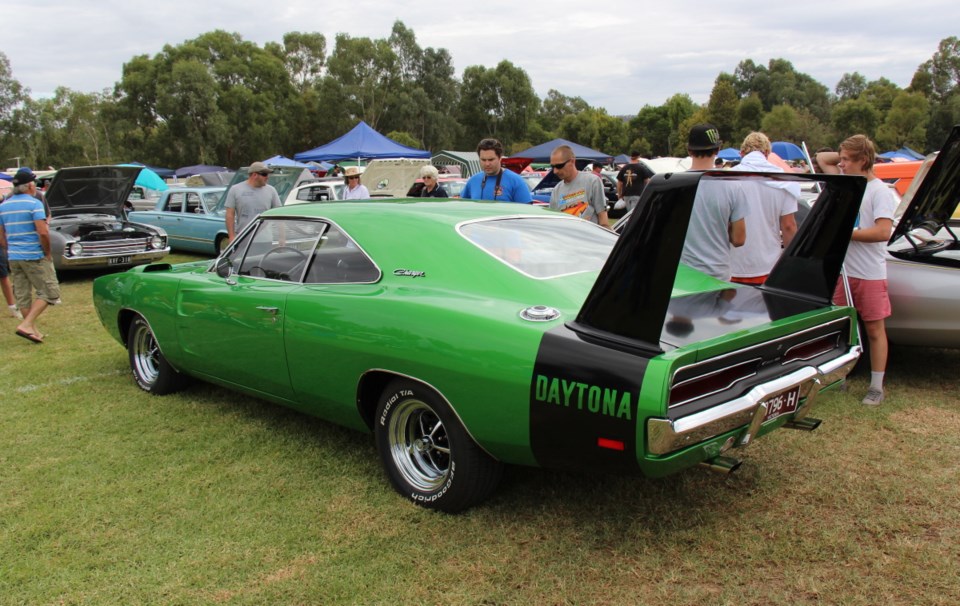The most audacious members of the muscle-car era that the Pontiac LeMans GTO launched in 1964 came near the end of Detroit’s big-engine-in-a-light-car performance orgy. They were Chrysler Corporation’s Dodge Charger Daytona and Plymouth SuperBird.
These “wing cars” with rear spoilers towering above the roof looked like they could be taken directly from showroom to stock car track. Indeed, they almost could. Chrysler built just enough of them to satisfy NASCAR that they were “production” cars.
The Daytona/Superbird’s progenitor appeared in 1966 as the fastback Dodge Charger, designed to compete with cars such as the Plymouth Barracuda, Rambler Marlin and Ford Mustang Fastback.
Through the mid-1960s, Dodge had some good years on NASCAR tracks, particularly after reviving the legendary Hemi V-8 in 1964. The Hemi became so successful that to keep the racing close, a NASCAR hallmark, it was temporarily banned from superspeedways.
With the 1966 fastback Charger, engineers hoped better aerodynamics would counteract NASCAR’s engine-rule fiddling. They concentrated on lower drag rather than higher horsepower and were able to give 1966 Charger enough aero aids to make it handle 290 km/h speeds.
Aerodynamicists took an even larger role in the reshaped 1968 Charger. Front fenders were sloped down at the front and the body bulged slightly front and rear with a narrower “coke bottle” middle. The flat rear window was flanked by flying buttresses extending back past the glass, giving a fastback look without actually being one. Like the ‘66, it had hidden headlamps.
While the new ’68 Charger was attractive and looked fast, wind tunnel testing revealed that the recessed grille and rear window created excess turbulence. More experimenting resulted in the 1969-1Ú2 Charger 500, named for the number of cars they planned to build to make it “production.” Making the grille and rear window flush lowered the drag.
Since the Charger 500 was purpose-built for NASCAR’s top Grand National circuits, the aerodynamicists continued refining it. They fitted hidden flip-up headlamps, a small chin spoiler and a long tapered nose cone with a shape optimized in the wind tunnel.
In the course of this aerodynamic fine tuning, the front end was lowered so much that the fenders scrubbed the tops of the tires while cornering. A reverse fender scoop solved the problem, fooling many observers into believing it was some secret and mysterious aerodynamic refinement.
The nose cone worked effectively but resulted in high-speed rear-end lift. This was counteracted with a high, strut-mounted “basket handle” rear wing. With these modifications, the Dodge Charger Daytona was born in 1969.
Chrysler knew they had a winner when a Daytona lapped the Chrysler proving ground’s eight-kilometre oval at more than 328 km/h in July 1969.
Chrysler intended to make the Daytona a 1970 model, but plans changed in the spring of 1969 when NASCAR announced the 1970 racing production-car minimum would increase from 500 to 2,000 identical cars.
Wanting to build only 500 Daytonas, Dodge advanced the schedule dramatically. To qualify as ’69s, the 500 cars had to be completed by September of that year. Dodge hired Detroit’s Creative Industries to assemble the Daytonas, and with a herculean effort they created 503 (best estimate) Daytonas within the deadline.
Dodge was concerned they would not be able to sell 500 Daytonas. They need not have worried, because when it was announced, orders poured in for 1,200.
Plymouth entered the wing-car game later, developing its SuperBird entirely in the wind tunnel. It fell under the new 2,000 production rule.
The 7.0-litre (426 cubic inch) Hemi-powered Daytona made its competition debut at Talladega, Alabama, in September 1969. It won against a field that had unfortunately been diluted by a drivers’ protest over the rough track and tire-failure concerns. Its big test would come the following year.
Any skepticism was silenced in 1970 when the Chrysler wing cars dominated NASCAR circuits; Plymouth SuperBird had 21 wins, and Dodge Daytona 17, Chrysler Corp.’s best racing year.
The wing cars had other triumphs, too. In March 1970 at Talladega, Buddy Baker’s Daytona became the first to exceed 322 km/h (200 mph) on a closed circuit. A Daytona was taken to Bonneville’s Salt Flats that September, where it set 28 United States Auto Club land speed records.
The wing cars’ success was their undoing. To slow them down, NASCAR reduced their engine size from 7.0 litres (426 cu in.) to 5.0 litres (305 cu in.) for 1971, curtailing their competitiveness. Also, because factories decreased racing financing drastically, wing-car development was reduced.
The Dodge Daytona and Plymouth SuperBird were a brief but spectacular chapter in muscle-car history. Their wonderful racing heritage make them very collectible today.



